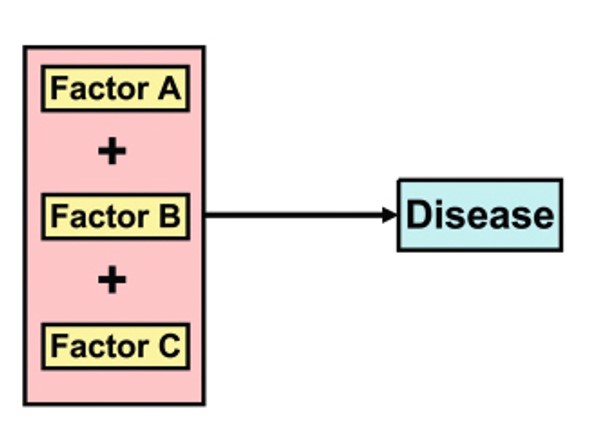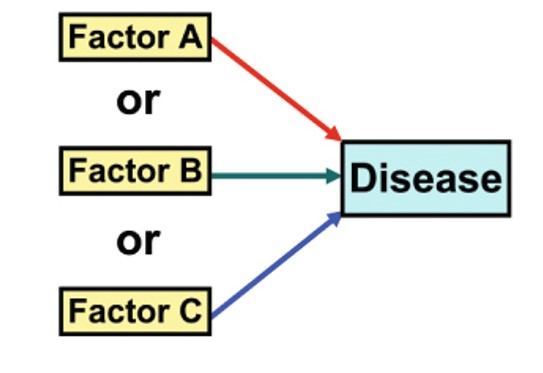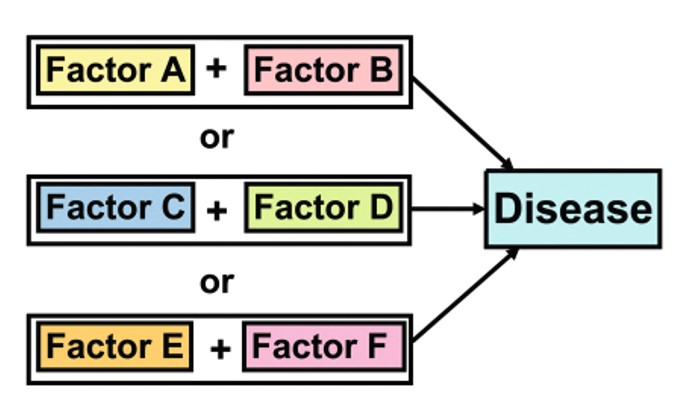Chapter 14 Epidemiology
1/32
There's no tags or description
Looks like no tags are added yet.
Name | Mastery | Learn | Test | Matching | Spaced |
|---|
No study sessions yet.
33 Terms
Spurious association
A false relationship between two variables caused by a third factor.
Causality
The direct cause-and-effect relationship between two variables.
In vitro study
Experiments conducted in a controlled environment outside a living organism, like in a lab.
“Unplanned” experiments
Experiments that occur without prior design or control, often in natural settings.
Disease etiology
The study of the causes or origins of diseases.
Confounding
A real association that is distorted because a third variable (the confounder) is related to both the exposure and the outcome Ex A study shows that coffee drinkers have higher rates of lung cancer. But if smokers tend to drink more coffee,
Bias
A systematic error that leads to incorrect conclusions.
Web of causation
A model showing how multiple factors interact to cause a disease.
Rothman’s Pie Chart
A diagram showing how different factors contribute to disease, with each factor being a component cause.
What are the advantages of using animal studies for determining disease etiology?
Controlled exposure and environment, minimal loss to follow-up, early testing before human exposure.
What are the disadvantages of using animal studies for determining disease etiology?
Uncertain if results apply to humans, some human diseases don’t occur with this, hard to doses, species may respond differently.
What are the advantages of using in vitro studies for determining disease etiology?
Allows researchers to study disease processes in a controlled and focused way, useful for testing how cells react to substances without involving animals or humans.
What are the disadvantages of using in vitro studies for determining disease etiology?
Results may not apply to real human bodies, doesn’t show how a substance affects the whole human organism.
How is ethical reasoning applied in human population randomized trials?
It is not appropriate when harmful exposures are involved, withholding benefits of known effective treatments, or when involving vulnerable groups.
What is the difference between association and causality?
Association means two things happen together; causation means one thing actually causes the other.
What are the four types of causal relationships?
Necessary and Sufficient; 2. Necessary but Not Sufficient; 3. Sufficient but Not Always Necessary; 4. Neither Sufficient Nor Necessary.
What is the role of the U.S. Preventive Services Task Force (USPSTF)?
Systematically reviews evidence and develops recommendations about preventive health services.
Relative Risk (RR)
The ratio of the incidence rate in exposed individuals to that in unexposed individuals; indicates the strength of association.
What is the USPSTF Grading System for Net Benefit?
It presents the balance of net benefit using letter grades from A to I, indicating the strength and certainty of recommendations.
What tends to come first association or causation?
Association comes first because researchers observe links before proving causation, which requires further evidence.
What does a USPSTF Grade A recommendation mean?
Strongly recommended; high certainty of substantial net benefit.
What does a Grade B recommendation mean?
Recommended; high certainty of moderate benefit or moderate certainty of moderate to substantial benefit.
What does a Grade C recommendation mean?
Offer selectively based on individual circumstances.
What does a Grade D recommendation mean?
Not recommended; no benefit or harms outweigh benefits.
What does an "I" statement mean from the USPSTF?
Insufficient evidence to assess the benefits vs. harms.
What are the strongest types of study designs for determining causality?
Experimental studies like randomized controlled trials (RCTs).
What study design ranks just below RCTs in strength?
Cohort studies.
case-control and cross-sectional studies
They are weaker than cohort studies; but stronger then case series and case reports in the hierarchy?
Why are RCTs the gold standard?
They randomize exposure, reducing bias and confounding.
What is a necessary and sufficient causal relationship?
The factor is both required and enough on its own to cause disease.

What is a necessary but not sufficient causal relationship?
The factor is required, but other factors must also be present.

What is a sufficient but not necessary causal relationship?
The factor alone can cause disease, but it's not the only possible cause.

neither sufficient nor necessary causal relationship
The factor alone can't cause disease and isn’t required for disease to occur.
